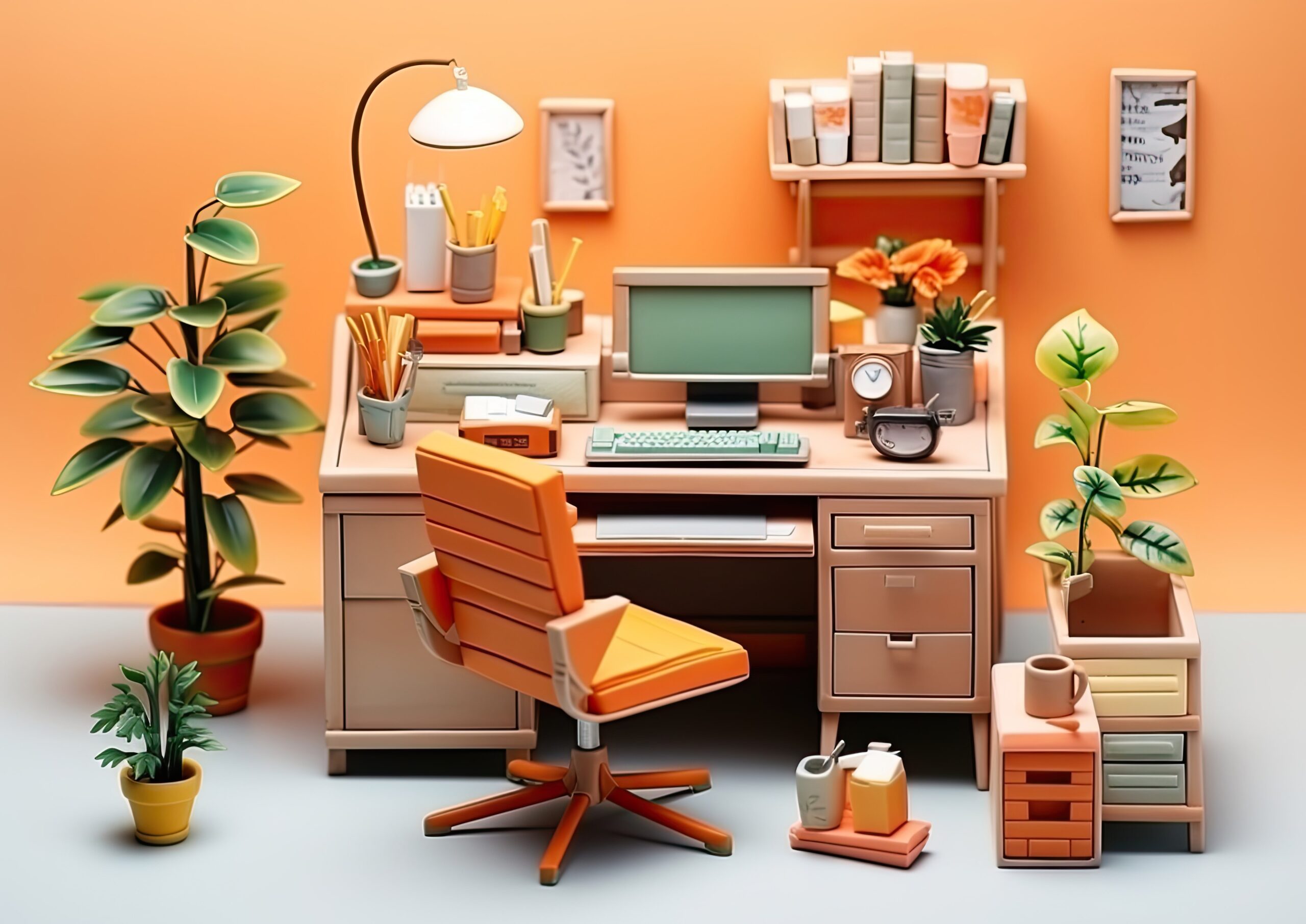10 Best Home Office Organization Tips and Tricks for Remote Workers
In today’s fast-paced world, more and more people are working from home, whether as freelancers, remote employees, or entrepreneurs.
However, creating a functional and organized home office can be challenging, especially if you have limited space.
Fortunately, with a little creativity and the right home office organization solutions, you can transform even the smallest of spaces into a productive and efficient workspace.
In this article, we’ll explore 10 of the best home office organization ideas to help you make the most of your small home office.
From clever storage solutions to multi-functional furniture, these tips will help you create a clutter-free and inspiring environment that promotes focus and productivity.
Whether you’re working from a dedicated room or a corner of your living space, these home office organization strategies will help you optimize your workspace and achieve your goals.
So, let’s dive in and discover how you can create the perfect small home office setup that works for you.
We strongly recommend that you check out our guide on how to take advantage of AI in today’s passive income economy.
Table of Contents
Maximizing Vertical Space
When it comes to home office organization in small spaces, one of the most effective strategies is to make use of vertical space.
By utilizing the walls and areas above your desk, you can free up valuable floor space and create a more organized and efficient workspace.
One popular solution is to install floating shelves or a pegboard above your desk, providing ample storage for books, documents, and office supplies.
This not only keeps your desk clutter-free but also allows you to easily access the items you need when you need them.
Another option is to use a tall bookshelf or storage unit that extends from floor to ceiling, maximizing the available space and providing plenty of room for storage.
You can also consider using wall-mounted file organizers or hanging storage pockets to keep important papers and documents within reach.
By thinking vertically and using the space above your desk, you can significantly improve your home office organization and create a more functional and productive environment.
Implementing Multi-Functional Furniture
Another key aspect of effective home office organization in small spaces is to invest in multi-functional furniture.
When every square foot counts, it’s essential to choose pieces that serve multiple purposes and help you make the most of your limited space.
One excellent example is a fold-down desk that can be easily tucked away when not in use, freeing up valuable floor space for other activities.
You can also opt for a desk with built-in storage, such as drawers or shelves, to keep your office supplies and documents organized and out of sight.
Another great option is a storage ottoman or bench that doubles as seating and provides hidden storage for items like printer paper or extra office supplies.
By choosing furniture that serves multiple functions, you can create a more efficient and organized home office, even in the smallest of spaces.
Look for pieces that are both practical and stylish, and don’t be afraid to get creative with your furniture choices to find solutions that work best for your unique needs and space constraints.
Decluttering and Minimizing
One of the most important aspects of effective home office organization is decluttering and minimizing the items in your workspace.
When you have limited space to work with, it’s crucial to be intentional about what you keep in your office and to regularly purge items that are no longer needed or used.
Start by going through your office supplies, paperwork, and other items, and ruthlessly eliminate anything that is outdated, duplicate, or unnecessary.
Be honest with yourself about what you truly need to be productive and efficient in your work, and let go of anything that is simply taking up valuable space.
Once you’ve decluttered, make a commitment to maintaining a minimalist approach to your home office organization.
Avoid the temptation to hold onto items “just in case,” and be selective about what you allow into your workspace.
By keeping your office streamlined and clutter-free, you’ll create a more peaceful and productive environment that promotes focus and efficiency.
Utilizing Door and Wall Space
In a small home office, every inch of space counts, so it’s important to think creatively about how you can utilize often-overlooked areas like doors and walls.
One simple but effective home office organization solution is to install an over-the-door organizer or pocket system.
These handy storage solutions can hold everything from office supplies and paperwork to electronics and personal items, keeping them easily accessible but out of sight.
You can also make use of wall space by installing a corkboard or whiteboard for brainstorming, note-taking, and displaying important information.
This not only helps keep your desk clear but also provides a visual reminder of your goals and priorities.
Another option is to use removable adhesive hooks or strips to hang items like calendars, planners, or artwork, adding both function and personality to your workspace.
By thinking outside the box and utilizing these often-overlooked spaces, you can significantly improve your home office organization and create a more efficient and inspiring work environment.
Incorporating Cable Management
In today’s digital age, most home offices are filled with a variety of electronics and devices, from computers and printers to phones and tablets.
While these tools are essential for productivity, the cords and cables that come with them can quickly become a tangled mess, cluttering your workspace and creating a visual distraction.
To keep your home office organized and streamlined, it’s important to incorporate effective cable management solutions.
One simple option is to use cable ties or clips to bundle cords together and keep them neatly tucked away.
You can also invest in a cable management box or sleeve that conceals cords and keeps them organized and out of sight.
Another option is to use a power strip with built-in cable management, which allows you to plug in multiple devices while keeping cords neatly contained.
By taking the time to properly manage your cables and cords, you can create a more organized and visually appealing home office that promotes focus and productivity.
Creating Designated Storage Zones
Another key strategy for effective home office organization in small spaces is to create designated storage zones for different categories of items.
By assigning specific areas for things like paperwork, office supplies, and personal items, you can keep your workspace organized and ensure that everything has a place.
One option is to use a small filing cabinet or storage boxes to keep important documents and paperwork organized and easily accessible.
You can also designate a specific drawer or shelf for office supplies like pens, paper, and staplers, making it easy to find what you need when you need it.
For personal items like keys, phones, and wallets, consider using a small tray or basket to keep them contained and easily accessible.
By creating these designated storage zones, you can keep your home office organized and clutter-free, even in the smallest of spaces.
Look for storage solutions that fit your specific needs and space constraints, and don’t be afraid to get creative with your approach to home office organization.
Embracing Digital Organization
In addition to physical home office organization solutions, it’s also important to embrace digital organization to keep your workspace clutter-free and efficient.
With so much of our work and personal lives taking place online, it’s easy for digital files and documents to become just as disorganized and overwhelming as physical clutter.
One effective strategy is to use cloud-based storage solutions like Google Drive or Dropbox to store and organize your digital files.
These platforms allow you to easily access your documents from any device, and many offer built-in organizational tools like folders and labels to keep your files neat and easy to find.
Another option is to use a digital note-taking app like Evernote or OneNote to keep track of important information, ideas, and to-do lists.
These apps allow you to easily capture and organize your thoughts, and many offer features like text search and tagging to make it easy to find the information you need when you need it.
By embracing digital organization and using these tools to streamline your workflow, you can create a more efficient and productive home office, even in the smallest of spaces.
Utilizing Under-Desk Storage
When it comes to home office organization in small spaces, it’s important to make use of every available inch, including the often-overlooked area under your desk.
By utilizing this space for storage, you can keep your workspace clutter-free and ensure that everything you need is within easy reach.
One option is to use a small filing cabinet or storage unit that fits neatly under your desk, providing ample space for paperwork, office supplies, and personal items.
Look for units with casters or wheels for easy access, and consider using drawer organizers or file folders to keep everything neat and easy to find.
Another option is to use under-desk storage boxes or baskets to corral items like cords, chargers, and extra office supplies.
These containers can be easily tucked away when not in use, keeping your workspace clean and organized.
If you have a bit more space under your desk, you might also consider using a small bookshelf or storage cube to keep books, binders, and other larger items organized and easily accessible.
By utilizing this often-overlooked space, you can significantly improve your home office organization and create a more efficient and productive workspace.
Personalizing Your Space
While home office organization is important for productivity and efficiency, it’s also essential to create a space that feels personal and inspiring.
After all, you’ll be spending a significant amount of time in your home office, so it should be a place that you enjoy being in and that reflects your personality and style.
One simple way to personalize your home office is to add a few decorative touches like artwork, plants, or photos that make you feel happy and motivated.
You might also consider using a fun and colorful mouse pad, pencil cup, or other desk accessories to add a pop of personality to your workspace.
Another option is to choose office furniture and storage solutions that reflect your personal style, whether that’s sleek and modern or cozy and rustic.
Look for pieces that not only serve a functional purpose but also make you feel good when you look at them.
By taking the time to personalize your home office and make it a space that you truly enjoy, you’ll be more likely to feel motivated and productive when working there.
So don’t be afraid to let your personality shine through in your home office organization and decor choices.
Regularly Reassessing and Adjusting
Finally, it’s important to remember that home office organization is an ongoing process, not a one-time event.
As your work and life evolve, so too will your organizational needs and preferences, so it’s essential to regularly reassess your space and make adjustments as needed.
Set aside time each month or quarter to take a step back and evaluate what’s working well in your home office and what could be improved.
Are there areas that tend to get cluttered or disorganized quickly?
Are there storage solutions that aren’t quite meeting your needs?
By regularly reassessing your space and making small tweaks and adjustments, you can ensure that your home office organization remains effective and efficient over time.
Don’t be afraid to experiment with new solutions or approaches, and be open to changing things up if something isn’t working as well as you’d like.
Remember, the goal of home office organization is to create a space that supports your productivity and well-being, so if something isn’t serving that purpose, it’s time to make a change.
By staying flexible and adaptable in your approach to home office organization, you can create a workspace that truly works for you, no matter how small or challenging the space may be.
In conclusion, creating an organized and efficient home office in a small space is all about being creative, intentional, and proactive in your approach.
By implementing these 10 best home office organization solutions, from maximizing vertical space and utilizing multi-functional furniture to embracing digital organization and regularly reassessing your needs, you can transform even the smallest of spaces into a productive and inspiring workspace.
Remember, the key to effective home office organization is to be mindful of your specific needs and space constraints, and to choose solutions that work best for you.
Don’t be afraid to experiment with different approaches and to make adjustments as needed over time.
With a little effort and creativity, you can create a home office that supports your productivity, efficiency, and well-being, no matter how limited your space may be.
So take the time to invest in your workspace and create an environment that truly works for you – your future self will thank you for it!
FAQ
How do you organize your home office?
Organizing your home office involves several key steps:
- Declutter and minimize: Remove any unnecessary items and keep only what you need for your work.
- Create designated storage zones: Assign specific areas for paperwork, office supplies, and personal items to keep everything organized.
- Maximize vertical space: Utilize wall space and areas above your desk for storage, such as floating shelves or pegboards.
- Invest in multi-functional furniture: Choose pieces that serve multiple purposes, like a desk with built-in storage or a storage ottoman.
- Manage cables and cords: Use cable ties, clips, or management boxes to keep cords organized and out of sight.
- Personalize your space: Add decorative touches that reflect your personality and make you feel motivated and inspired.
How do I organize my home work?
To organize your home work:
- Create a dedicated workspace: Set up a specific area in your home for work, separate from leisure and relaxation spaces.
- Establish a routine: Set regular work hours and stick to a schedule to maintain a work-life balance.
- Use time management techniques: Implement strategies like the Pomodoro Technique or time blocking to stay focused and productive.
- Prioritize tasks: Use to-do lists, planners, or digital tools to prioritize your tasks and stay on track.
- Embrace digital organization: Utilize cloud-based storage and digital note-taking apps to keep your digital files and documents organized.
- Take breaks: Regular breaks help maintain focus and prevent burnout, so make sure to step away from your work periodically.
How do I set up a home office?
Setting up a home office involves several considerations:
- Choose a dedicated space: Select an area in your home that can serve as your workspace, ideally separate from high-traffic or leisure areas.
- Invest in essential equipment: Ensure you have a comfortable chair, a desk of appropriate height, and any necessary technology like a computer, printer, or phone.
- Consider lighting and ergonomics: Make sure your workspace has adequate lighting and that your furniture is ergonomically suitable to prevent strain or injury.
- Organize your space: Implement storage solutions, cable management, and other organizational strategies to keep your workspace clutter-free and efficient.
- Personalize your environment: Add personal touches like artwork, plants, or photos to create a space that feels inviting and inspiring.
What is the meaning of office organization?
Office organization refers to the process of arranging and managing a workspace to optimize efficiency, productivity, and comfort. This involves:
- Physical organization: Arranging furniture, storage, and equipment in a way that promotes workflow and minimizes clutter.
- Digital organization: Managing digital files, documents, and communication channels to streamline processes and improve accessibility.
- Time management: Implementing strategies and techniques to prioritize tasks, minimize distractions, and maintain focus.
- Continuous improvement: Regularly reassessing and adjusting organizational systems to ensure they continue to meet the changing needs of the work environment.
Effective office organization creates a workspace that supports the specific needs and goals of the individual or team, promoting a more productive and satisfying work experience.

We strongly recommend that you check out our guide on how to take advantage of AI in today’s passive income economy.




